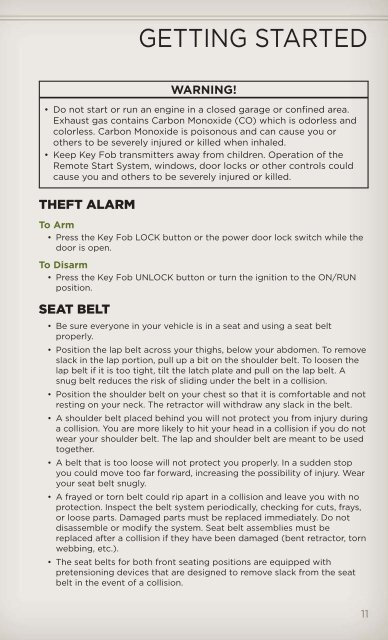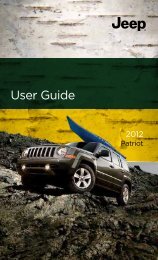2012 Jeep Wrangler User's Guide - AMERICAN AUTO CLUB
2012 Jeep Wrangler User's Guide - AMERICAN AUTO CLUB
2012 Jeep Wrangler User's Guide - AMERICAN AUTO CLUB
Create successful ePaper yourself
Turn your PDF publications into a flip-book with our unique Google optimized e-Paper software.
GETTING STARTED<br />
WARNING!<br />
• Do not start or run an engine in a closed garage or confined area.<br />
Exhaust gas contains Carbon Monoxide (CO) which is odorless and<br />
colorless. Carbon Monoxide is poisonous and can cause you or<br />
others to be severely injured or killed when inhaled.<br />
• Keep Key Fob transmitters away from children. Operation of the<br />
Remote Start System, windows, door locks or other controls could<br />
cause you and others to be severely injured or killed.<br />
THEFT ALARM<br />
To Arm<br />
• Press the Key Fob LOCK button or the power door lock switch while the<br />
door is open.<br />
To Disarm<br />
• Press the Key Fob UNLOCK button or turn the ignition to the ON/RUN<br />
position.<br />
SEAT BELT<br />
• Be sure everyone in your vehicle is in a seat and using a seat belt<br />
properly.<br />
• Position the lap belt across your thighs, below your abdomen. To remove<br />
slack in the lap portion, pull up a bit on the shoulder belt. To loosen the<br />
lap belt if it is too tight, tilt the latch plate and pull on the lap belt. A<br />
snug belt reduces the risk of sliding under the belt in a collision.<br />
• Position the shoulder belt on your chest so that it is comfortable and not<br />
resting on your neck. The retractor will withdraw any slack in the belt.<br />
• A shoulder belt placed behind you will not protect you from injury during<br />
a collision. You are more likely to hit your head in a collision if you do not<br />
wear your shoulder belt. The lap and shoulder belt are meant to be used<br />
together.<br />
• A belt that is too loose will not protect you properly. In a sudden stop<br />
you could move too far forward, increasing the possibility of injury. Wear<br />
your seat belt snugly.<br />
• A frayed or torn belt could rip apart in a collision and leave you with no<br />
protection. Inspect the belt system periodically, checking for cuts, frays,<br />
or loose parts. Damaged parts must be replaced immediately. Do not<br />
disassemble or modify the system. Seat belt assemblies must be<br />
replaced after a collision if they have been damaged (bent retractor, torn<br />
webbing, etc.).<br />
• The seat belts for both front seating positions are equipped with<br />
pretensioning devices that are designed to remove slack from the seat<br />
belt in the event of a collision.<br />
11



